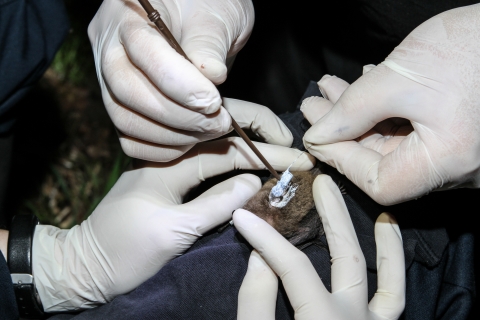Asheville, North Carolina - On May 9, 2016, biologist Chris Kelly saw a lone bat on a bridge crossing the French Broad River outside Asheville, North Carolina. Five years later, everything wildlife biologists thought they knew about endangered gray bats in this corner of the Blue Ridge Mountains has been upended.
Kelly, a biologist with the N.C. Wildlife Resources Commission, was on the bridge doing bird work. Bats aren’t her area of expertise, so she reached out to the state’s bat experts. Joey Weber, a technician who was working for the Commission, arrived at the bridge later that day and found 19 big brown bats roosting in the expansion joints. But he heard many more.
That night, Weber was joined by Katherine Etchison, the Commission’s bat biologist, for an emergence count – when biologists count how many bats emerge from a roost at dusk. They counted 240, but a busy schedule meant the team couldn’t return for a second emergence count until July 18.
“I was very eager to get back out there because I really thought there would be something besides big brown bats. I was thinking Mexican free-tailed bats, which would be a first for Buncombe County, and I was right but that wasn’t the big news,” said Etchison.
The second emergence count tallied 1,000 bats. To learn which species used the bridge, biologists recorded the ultrasonic sounds made by emerging bats, which are species-specific. Later that night, Etchison scrolled through the recorded calls, displayed graphically on her computer, and the suspected Mexican free-tailed bats showed up. But, so too did something very unexpected.
She immediately texted Susan Cameron, an Asheville-based biologist with the U.S. Fish and Wildlife Service (Service) – the agency that coordinates the recovery of federally threatened and endangered species. Along with big brown and Mexican free-tailed bats, the computer identified the calls of endangered gray bats. The discovery was confirmed the next day when Etchison, Weber, and Cameron visited the bridge at dusk – just before bat emergence – and carefully captured a bat from one of the expansion joints.
Big discovery
The gray bat was placed on the federal threatened and endangered species list in 1976. The first record of a gray bat in North Carolina dates from 1968, when a bat that was banded in Tennessee that July was pulled from the grill of a car near Swannanoa in October. Western North Carolina is on the edge of their range. Gray bats were considered cave-dwellers, their range centered on the cave-rich landscape of Tennessee and Kentucky.
In North Carolina, before 2016, only 13 gray bats had turned up in years of routine bat surveys. Three more had been randomly found, including the one in the car grill. Gray bats are known to cover a lot of ground, so it was assumed any found in North Carolina were simply Tennessee bats passing through.
The bridge discovery triggered an intense search of 71 bridges across western North Carolina in late-summer and early-fall 2016, during which biologists uncovered six more gray bat roosts – all in Madison and Yancey counties. The 2016 discoveries marked the first time gray bats were known to roost in North Carolina. Biologists were excited.
Meanwhile, the North Carolina Department of Transportation (NCDOT) was moving forward with plans to modify the I-26 corridor through Asheville. These two seemingly disparate trajectories would quickly come together and take knowledge of gray bats in the French Broad River basin to a new level.
Enter the interstate
The Endangered Species Act requires federally funded or authorized projects be reviewed for impacts to federally threatened or endangered species. NCDOT worked with the Service to minimize the impact of the I-26 work on gray bats. This included things like timing work to lessen impacts to bats traveling and foraging along the river, and ensuring construction-related lighting falls only where necessary. NCDOT also brought in bat experts from Indiana State University to identify areas the bats used for roosting and travel.
“Having the Indiana State University researchers track these gray bats was key to developing two avenues for conserving them,” said Cameron. “First, it lets people developing projects in the French Broad corridor know where these endangered bats are, enabling them to plan accordingly and minimize negative impacts. Second, it allows wildlife biologists and conservationists to focus on areas that are truly important for the bats.”
It was not the first time NCDOT had taken imperiled bats into consideration. North Carolina’s only population of endangered Virginia big-eared bats winter in the caves of Grandfather Mountain. They leave the caves each spring, traveling to a maternity roost to give birth and raise their young. While no one knew the location of the maternity roost, there was concern the widening of NC 105 would impact maternity areas and migrating bats. To minimize the project’s potential impact to the imperiled bats, the NCDOT brought in researchers to track the bats, learn their migration routes, and discover the maternity roost. The discovery paved the way for a philanthropist to acquire the maternity roost property, now protected by the state of North Carolina.
Right under our noses
With a nearby outdoor concert providing background music, a stream-side team of wildlife biologists was busy gluing tiny radio transmitters to gray bats along a section of the French Broad River in Asheville. It was 2018 and, for the next two years, the biologists tagged bats at numerous roosting sites across the French Broad basin.
The radio signals were picked up by temporary telemetry towers, antennae held by biologists driving the river basin, and, on occasion, airplanes carrying receivers. After several days, the glue fails and the transmitters fall off, leaving the bats none the worse for wear. In addition to the radio telemetry, 15 acoustic detectors were scattered across the basin to determine bat presence and species.
At the beginning of 2016 there were no known gray bat roosts in North Carolina. Any time they were found, it was considered a fluke – a lone Tennessee bat venturing out into the wider world. Today, thanks to the Indiana State University researchers and a handful of other organizations, the number of roosts approaches 40. They’re found across the French Broad River basin, including tributary streams from the Pigeon River in Haywood County to the North Toe River in Avery County.
Most of the roosts are bridges, but the list also includes culverts, buildings, and trees. The list did not include a single cave or mine - the major roosting sites for gray bats. The research also revealed that the bats are warm-season visitors, arriving in early spring, then departing in fall, to likely winter in Tennessee caves.
“Discovering the gray bats was cool, and everything we’ve learned since is hopeful,” said Etchison. “They may have been here in small numbers before, but seem to be expanding their range. Similar species, like Indiana, northern long-eared, or little brown bats have declined over 90 percent in western North Carolina due to white-nose syndrome. In contrast to all that bad news about bats, this gives me a little hope for this species.”
Etchison noted her team is now catching gray bats at long-term bat survey sites along Bent Creek and the Davidson River, where they weren’t seen before.
“I love the idea of discovery, and of a bat proving you wrong,” she said. “We didn’t think it was really in North Carolina and we thought it was a cave bat. It’s broken both of those rules and I like that. That’s science. That’s why we do this – to learn more about our world. Where would we be now without Chris’s first sighting on that bridge five years ago?”






